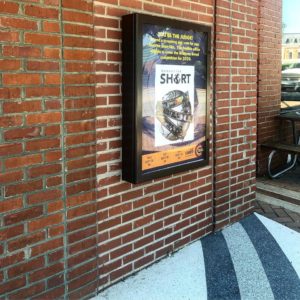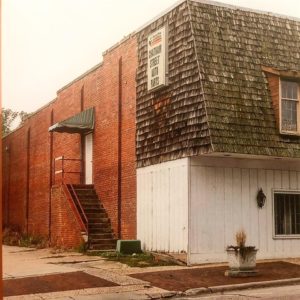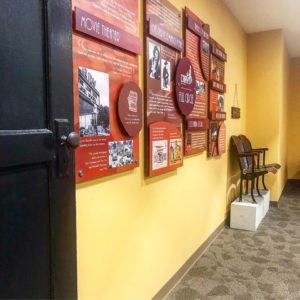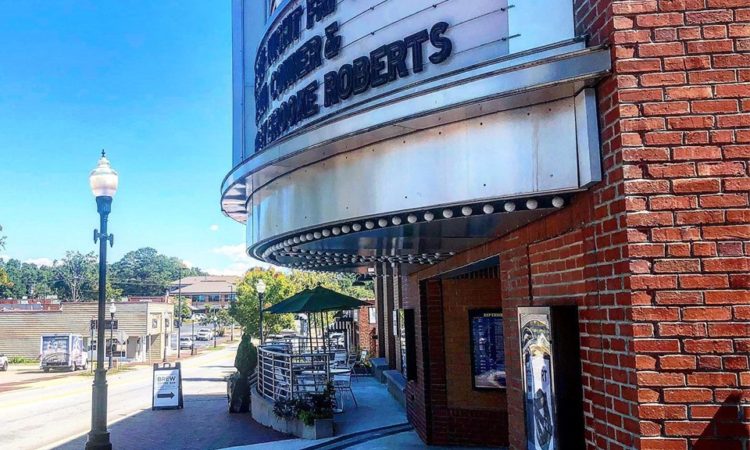Standing in line for tickets at The Cary Theater, it’s easy to miss the bricked-up entrance that was originally built during an era of racial segregation. If you look closely at the movie poster by the front door, you can see the brick wall forms a door-shaped indentation behind the movie poster display. Back in 1946 when the theater was built, this “secret entrance” would lead African-American guests directly to the balcony seating, ensuring they remained separate from the white audience below.

“Aside from the main segregated entrance, there was also a stairway on the side of the building that led the black guests to separate concessions,” said Peggy Van Scoyoc, who serves as Cary’s oral historian.
Finding History in the Walls
The structure housing the modern-day Cary Theater has been through several shifts in identity and multiple owners. While it made history as the first in-door theater in Cary, it later became Cary Clothiers, a clothing store. After that, it was a recording studio, then an auto-parts store. By the time it became Chatham Street Auto Parts, a facade had been built to disguise the structure’s roots as a theater, and the building was nearly unrecognizable from its 1940s origins.
Because of these structural shifts, the actual location of the segregated side door to the concession stand can be difficult to pinpoint. However, if you’ve ever sipped a latte inside The Cary’s BREW Coffee Bar, you’ve seen the original exterior wall where the stairs once attached. That exterior wall is now an interior brick wall, decorated with modern art and trendy modern designs.
Joy Ennis, the Operations & Program Supervisor of The Cary, points to a few places where the brick wall divots in by about one or two inches, runs for a few feet, then divots back out. If you compare this to old photos of the exterior wall, you can see this same design feature outside the original theater. “If you look closely at old photos,” explains Ennis, “You can see the side door to concessions sat right between the first and second row.”

Following those structural clues, the stairway and door might have been very close to the current interior doorway leading to the upstairs meeting area, where locals often sit to hold meetings or do work. In the 1940s, this would have been an exterior wall with a brick and concrete stairway running alongside it. Today, it’s an interior wall with a spiral metal staircase, leading to a double door-sized opening in the brick.
Preserved Pieces of the Original Theater
In 2011, the Town of Cary purchased the deteriorating building as part of a downtown revitalization plan. After decades of hiding behind a facade, the structural mask was finally removed. It would return to its roots as a theater.
The town began a year-long restoration project to revive the theater with a focus on film, youth and amateur theater, live music, and cultural arts. While the new Cary Theater has no connection to the original theater, the Town strives to keep the history accessible. The entrance from the era of segregation is bricked over, but the upstairs meeting room has a small museum to the structure’s history.

The most eye-catching piece is a pair of theater seats from the original theater. Their rich brown wood matches with the other show-stopper: An original wooden door which once led to the segregated concession stand.
An oddly out-of-place mural of an enormous sun harkens back to when the building was used as a recording studio. The section of mural was preserved, while the accompanying moon mural is long gone.
Half of a torn, faded movie ticket sits in the display, as well. According to the print, it was only 40 cents to see a movie at the theater back then. Chatham Street was very different in those days, with Mitchell’s Pharmacy sitting next door, where Pharmacy Bottle + Beverage sits today, and Henry Adam’s Drugstore had never even heard of Ashworth’s yet.
Ennis stresses the importance of preserving the building’s history. She believes it’s important to remember the roots of your community, and to know the history of where you live.
Maintaining Chatham Street’s Historic Roots
Much like Pharmacy Bottle + Beverage has kept roots tied to the building’s historic background, The Cary Theater’s design echoes its origins. The iconic marquee casts a nostalgic glow over Chatham Street. The curved lines on the sidewalk, mirrored by small rows of bare bulbs above, evoke the stylings of the mid-1900s. Everything from the authentic wooden ticket counter to the spiral staircase call to mind the grandeur of the art deco era, when going to the theater was a special occasion.
The new design does more than highlight the majesty and nostalgia of the 1940s and 50s. It also acknowledges the structure’s roots in the era of segregation, saving the doors and balcony seats as a reminder of a part of history that should never be repeated.
While plenty of Cary history is etched in the walls of this 70-year-old building, the primary goal of The Cary goes deeper. Just like in those days when crowds gathered to hear Patsy Cline or watch old-timey Westerns, The Cary hopes to bring the community together. Offering screenplay competitions for local writers, a Cary Film Festival to highlight community talent, fundraisers for local non-profits, and a variety of workshops, The Cary builds and bolsters our cultural arts community. Instead of old westerns, crowds can gather for a week of classic horror movies for Halloween. Instead of Patsy Cline, we’ll hear Bill Leslie perform his storytelling songs, or listen to professional storytellers at the Old North State Storytelling Festival.
Or you can just sit with a quiet cup of coffee at BREW, and listen to the stories in the walls.

